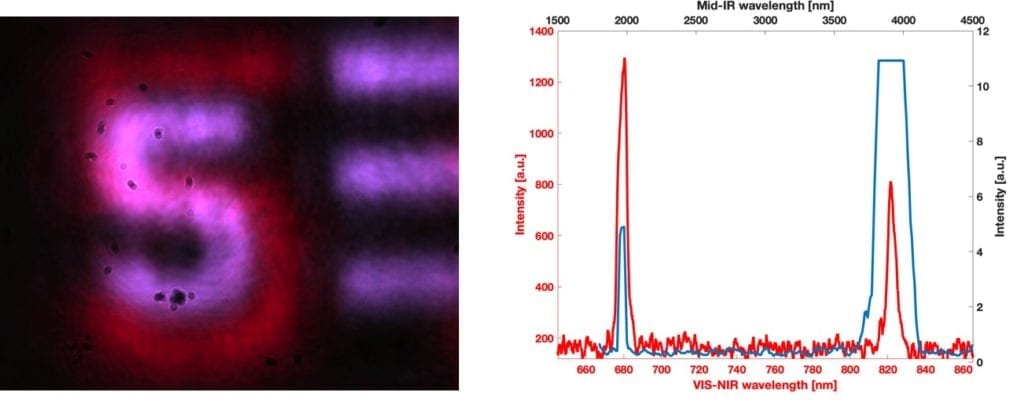Humans looking at a valley of rainbow-hued flowers or a beautiful painting in a museum think they are very good at seeing colors.
Unlike some better-endowed animals, we have only three cones in our eyes that allow us to see the three primary colors (blue, red and yellow) and secondary colors made by mixing those colors (orange, brown, purple and green). These colors are the visible light spectrum, part of the electromagnetic spectrum.
In fact, there are numerous types of animals that can detect many more hues than man. The creature with the best color vision is the bluebottle butterfly, which sees an unbelievable array of shades. Eagles see colors more vividly than we do – even ultraviolet (UV) light, which gives them the ability to spot traces of urine left by prey.
Many materials have a unique signature – expressed as color – in the mid-infrared range, which is undetectable by the human eye or a “standard” camera.
Tel Aviv University (TAU) researchers have discovered a new technology that will allow us to identify on a standard camera colors that the human eye and even ordinary cameras are unable to pick up. Among other things, the new technology will make it possible to image gases and substances such as hydrogen, carbon and sodium, each of which has a unique color in the infrared or different biological compounds that are found in nature but are “invisible” in the visible.
The new technology also has groundbreaking applications in a variety of fields – from gaming and photography to security, medicine (including the detection of cancer) and remote sensing satellites in space. The new technology will allow standard cameras to pick up those colors.
The groundbreaking research was conducted by Dr. Michael Mrejen, Yoni Erlich, Dr. Assaf Levanon and Prof. Haim Suchowski at TAU’s department of physics of condensed material. The results of the study were recently published in the peer-reviewed journal Laser & Photonics Reviews under the title “Multicolor Time‐Resolved Upconversion Imaging by Adiabatic Sum Frequency Conversion,”
“The human eye picks up photons at wavelengths between 400 nanometers – the blue color – and 700 nanometers – the red color,” said Dr. Mrejen. “But it is only a tiny part of the electromagnetic spectrum, which also includes radiowaves, microwaves, X-rays and more. Below 400 nanometers, there is UV radiation, and above 700 nanometers, there is infrared radiation, which itself is divided into near, mid and far infrared. In each of these parts of the electromagnetic spectrum there is a great deal of information on materials encoded as ‘colors’ that has until now been hidden from view.”
According to the researchers, the color in these parts of the spectrum is of great importance, since many materials have a unique signature, expressed as color, especially in the mid-infrared range. So, for example, cancer cells could be easily detected as they have a higher concentration of molecules of a certain type. Existing infrared detection technologies are expensive and mostly unable to render those “colors.”
In medical imaging, experiments have been performed in which infrared images are converted into visible light to identify the cancer cells by the molecules. Until now, this conversion has been carried out color by color; this required very sophisticated and expensive cameras, which were not necessarily accessible in the civilian sector.
In the study, the researchers were able to develop cheap and efficient technology that could mount on a standard camera that allows for the first time the conversion of light photons from the entire mid-infrared region to the visible region at frequencies that the human and standard camera can pick up.
“In the mid-infrared range, there is a one-to-one relationship between materials and their mid-infrared ‘colors,’ especially organic molecules,” explained Suchowski. “This means that different materials have a different ‘fingerprint’ color. We humans see between red and blue. If we could see in the infrared realm, we would see that elements like hydrogen, carbon and sodium have a unique color. An environmental- monitoring satellite that would take a picture in a certain region and would see a pollutant being now emitted from a plant or a spy satellite would see where explosives or uranium are being hidden. In addition, since every object emits heat in the infrared, all this information could be seen even at night.”
After registering a patent for their invention, the researchers are now developing the technology through a grant from the Israel Innovation Authority’s KAMIN incentive project, which serves as a bridge between basic and applied research and is focused on the stage of transformation and realization of basic research achievements into technologies with commercial application. It is meant to encourage applied research in the academic research institutions that can attract the investment interests of businesses willing to cooperate with the research institution towards a commercialization agreement.
The incentive program is aimed at research groups from Israeli universities, colleges, public research institutes and medical centers that want conduct applied research, building upon the basic research. The research must be innovative and original in terms of industrial application; its results should be applicable to industry. The TAU team have already met with a number of companies in Israel and abroad.



